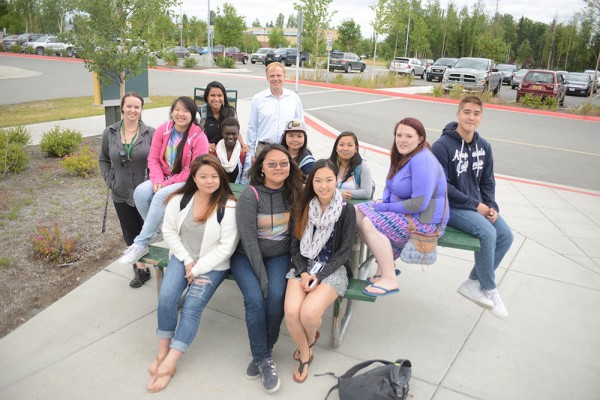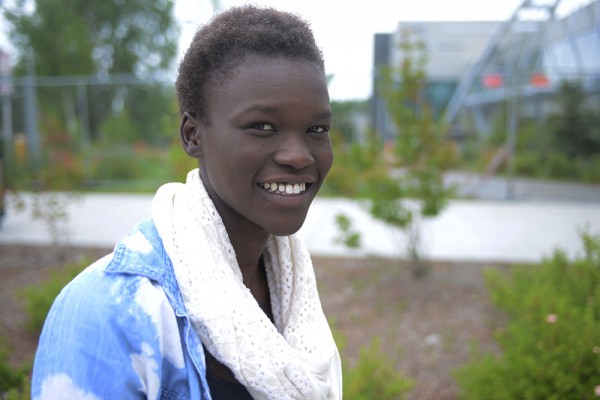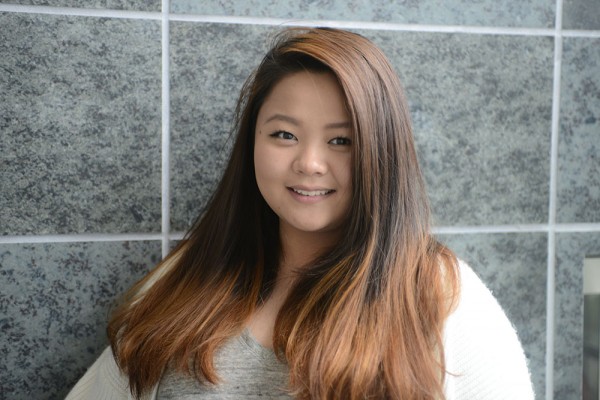'This program helped me figure out more, to make sure I want that career'
by Tracy Kalytiak |
Awar Mou's mother moved nine of her children from South Sudan to the United States 11 years ago, because she wanted to provide a better education and a better life for them.

Ten teens from Anchorage and other parts of Alaska are taking part in this summer's UAA Della Keats health education program. (Photo by Tracy Kalytiak/University of Alaska Anchorage)
"She didn't want us to have to live the way she did," Awar, 17, said. "She struggled a lot in South Sudan. When we finally got here two years ago, she found a job as a housekeeper for the Alaska Native hospital."
Awar started looking toward her own future when she was in the eighth grade, researching anesthesiology for middle school career day. Earlier this year, her friend told her about UAA's Della Keats Health Sciences Summer Program.
"At first I thought it was a joke," she said. "There's no way you can go to a program that would pay you just to go and learn all these amazing things. I applied for it-I thought it would be a good opportunity to see how the medical industry really is."
Now, through Della Keats, Awar has taken introductory classes in medical terminology, anatomy and physiology, microbiology, biomedical ethics, communication and the scientific method. She's provided medical care to robotic "patients" at UAA's simulation lab. Through Della Keats' job-shadowing opportunities, she's helped in respiratory therapy, progressive care and a newborn intensive care unit.
"That was really awesome," Awar said. "I got to hold one yesterday."
Della Keats helped Awar clarify her goals and start preparing a solid foundation for college.
"Now I know so much," she said. "There are so many things I could do inside the medical field, but then I could do so many things outside the medical field that still have to do with the medical field. And I didn't know that. I thought, wait, I could be a lawyer for the medical field? That's awesome. If I change my mind on being a doctor, I could go outside the box and be a social worker or lawyer or anything I want to be and still be involved in the medical field and have a medical background."
Providing the program
The Della Keats programs are named for Della Puyuk Keats, an Iñupiaq woman with no formal education but an interest in human anatomy and folk medicine. She became a traditional healer in the Kotzebue area.
DK1, (the Della Keats Health Sciences Summer Program) and DK2 (the Della Keats Summer Research Program) provide no-cost opportunities for eligible high school juniors and seniors to spend six weeks of their summer in UAA dorms-supervised, no drugs or alcohol allowed-while working full time to job-shadow doctors, nurses and dentists and learn academic skills they'll need if they aspire to become a health care professional.
To be eligible, students applying for one of the programs must have a grade-point average of 3.0 or above in challenging courses, write an essay about why they want to become a health care professional, submit letters of recommendation and meet one or more of the following criteria:
• Come from an ethnic background that is underrepresented in medicine.
• Live in rural Alaska, off the road system.
• Be a first-generation American.
• Be the first in his or her family to go to college.
• Speak English as a second language.
• Be economically disadvantaged.
DK1 students learn anatomy and physiology, microbiology and genetics, biomedical ethics, medical terminology, lab procedures, medical diagnosis and treatment (using SIM manikins), written and oral communication, college survival skills, money management and how to use computers and other technology.
DK1 students may apply to return for a second summer to take part in DK2, said Cassandra Dale, Della Keats program coordinator. DK2 students are effectively research interns-spending their days working on biomedical or public health-related research projects under the supervision of UAA faculty. The two programs run concurrently, so the DK2 students are also able to act as mentors to the younger students in the dormitories.
To help students learn money-management skills before college, the Della Keats students each receive a stipend that's doled out in installments over the six weeks. Breakfasts are provided but students are expected to use their stipend to pay for lunches, dinners, entertainment and any other incidental expenses.
Dr. Ian van Tets, director of the program, says the Alaska WWAMI School of Medical Education, the Alaska Kidney Foundation and a number of individual private donors provided the funding for this year's Della Keats programs; the Foundation allowed Della Keats to use money it previously donated to the College of Health, and intends to continue to support both Della Keats programs into the future. "The students were assigned kidney- and diabetes-themed research projects this year in recognition of this gift," van Tets said.

Awar Mou, 17, has enjoyed the job-shadowing and academic opportunities UAA's Della Keats health education program has offered. (Photo by Tracy Kalytiak/University of Alaska Anchorage)
In-kind support comes from many UAA programs, including Alaska WWAMI and the SIM lab associated with the nursing program.
South Central Alaska Area Health Education Centers, Providence Alaska Medical Center, Orthopedic Physicians Anchorage and Alaska Regional Senior Health Care Clinic provide job-shadowing options for the students.
During their six weeks in Della Keats, the youths had the chance to hear guest speakers and take tours, interacting with people from UAA's RRANN, NSS, Allied Health and DENTEX programs as well as from the Blood Bank of Alaska, Alaska State Public Health Laboratory and Alaska Community Mental Health Services.
The cost for each student to take the classes and live on campus is approximately $8,000, van Tets said.
The money pays for the stipends, travel for rural students, housing, salaries for dorm staff, instructors, administrators, lab supplies, teaching supplies and textbooks.
"We did have less funding than normal this year and we reduced the number of staff in housing and in administration and instruction to balance the budget and ensure we could provide an appropriate program to our 10 students," he said.
While the state budget crisis hasn't directly affected the Della Keats program-it doesn't receive any money from the UA operating budget and has been self-funding for at least 10 years-it has affected the ability of other programs and departments to help Della Keats.
Just over 40 eligible youths applied for Della Keats this year. Four of the 10 students accepted came from Anchorage, two came from Bethel and the others came from Kasigluk, Tok, Tuluksak and Unalaska.
"Being residential is...of fundamental importance to our mission," van Tets said. "Our aim is to help talented Alaska students transition smoothly into college and on into the health professions, and we want to focus our resources on the students who need the help most. Going nonresidential would exclude rural Alaskans from our program and the students that did join the program would no longer gain the campus living skills that six weeks of dorm life provides."
Van Tets says staying residential enables Della Keats to serve students from all over the state, and enables those students to learn, firsthand, the challenges of dorm life, to make friends and to make mistakes.
"When our (DK) graduates do continue on to college, they arrive at college knowing what to expect and with a suite of friends to turn to," he said. "For a teenager from a small village, that knowledge and those friends can be a lifesaver-keeping them sane during those first few weeks and months and enabling them to stay the course and go on to complete their degrees."
'This program helped me figure out more'
Summer Lee, 17, is passionate about science. She's vice president of the science club at East High and loves chemistry and biology. Her goal is to become a pharmacist.

Summer Lee, 17, is participating in UAA's Della Keats program. She hopes to become a pharmacist. (Photo by Tracy Kalytiak/University of Alaska Anchorage)
Her friend took part in Della Keats last year, so Summer applied for this year's session.
"I was looking for a summer program," she said. "Once I got in, I was super happy-I was jumping around my room!"
Summer met and observed doctors and nurses doing their jobs, learned about radiology, and job-shadowed a pharmacist.
She's almost reached the end of this year's Della Keats term and has made a decision about her goal.
"My first choice would be a pharmacist," Summer said. "I'll need a lot of schooling and will need to find a lot of scholarships. I have to work hard, of course. I'm pretty motivated right now because this program helped me figure out more, to make sure I want that career."
Written by Tracy Kalytiak, UAA Office of University Advancement
 "'This program helped me figure out more, to make sure I want that career'" is licensed under a Creative Commons Attribution-NonCommercial 4.0 International License.
"'This program helped me figure out more, to make sure I want that career'" is licensed under a Creative Commons Attribution-NonCommercial 4.0 International License.














